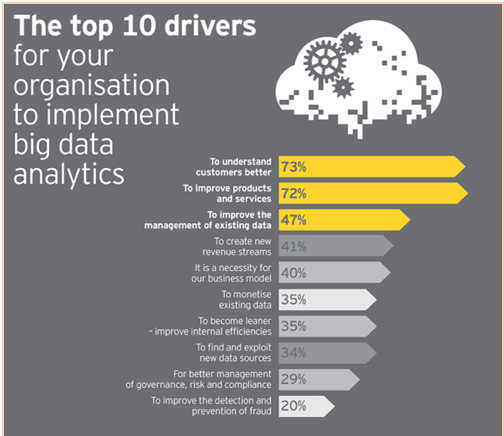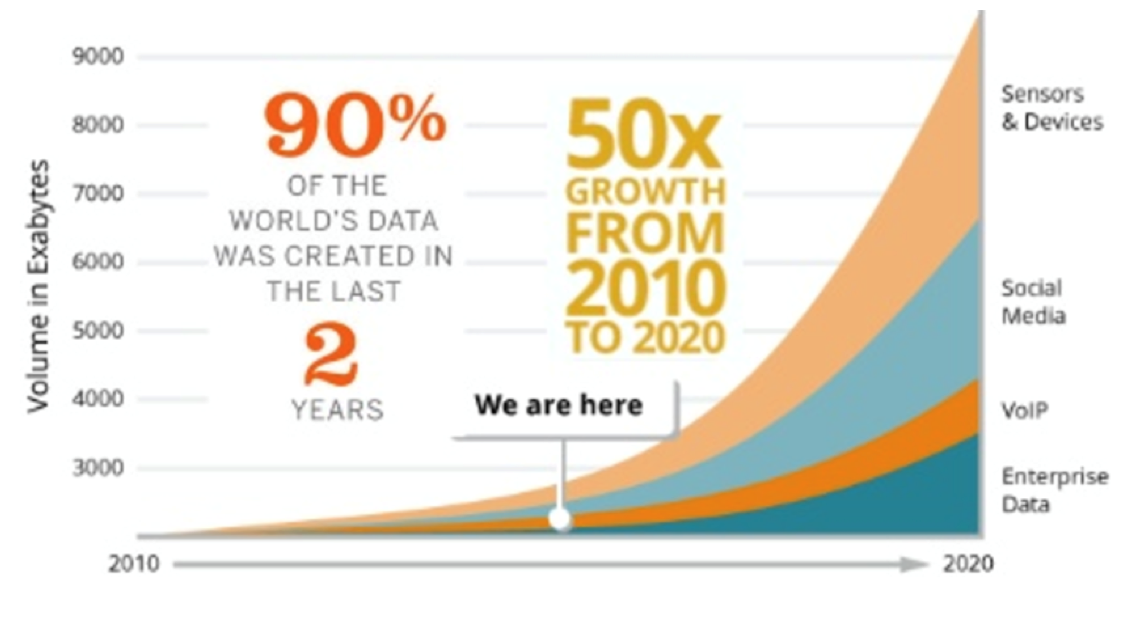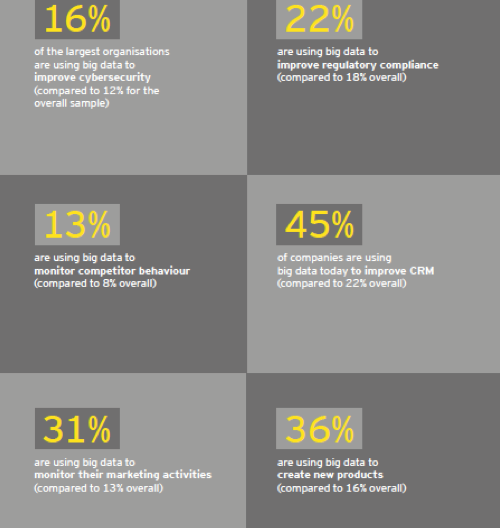Wrapping your hands around Big Data is one of the key success factors in generating results in digital. Collecting it and knowing what insights to glean from the mass of data is one of the valuable learning experiences in scaling a digital operation.
The Big Data Revolution
When we say Big Data, we refer to the management of unstructured data and the use of analytics to derive value from it. It has spawned a revolution in the startup world and released a storm of platform options from which to choose, including giants like IBM, AWS, Azure, SAP, Salesforce, Oracle and more. Data is collected from a wide variety of sources, including social media, emails, chat, iOT, connected devices, locations, purchases, memberships and browsing history - to name a few. “Big Data Analytics” then uses that data to create actionable insights about customer behaviors, which we display for management in dashboards.
Big Data initiatives are key to boosting business performance: A recent study by Ernst & Young shows that 81 percent of top executives interviewed agree that the standardization, automation and governance of data is critical for the future of their companies.

Some of the benefits of Big Data analytics, according to the EY study, include:
- New Revenue Streams
- Better understanding of customers
- Improved internal efficiency
- Improved risk management
- Improve products and services
These may seem like broad business goals, but the impact of Big Data analytics on profit and operations is substantial. But, and a Big But, as good as Big Data analytics can be, these systems are only reliable and actionable if 1) the right data is collected, 2) the insights that emanate from the process are shared throughout the organization 3) stakeholders implement changes and improvements on a regular basis and 4) actionable insights are essential to the decision-making process going forward.

How Big Data Analytics Works
From the early days of the Internet, data has been produced in ever-increasing amounts. Globally, until 2003, people around the world had generated about 5 billion gigabytes of data in total, according to University of California statistics. By 2012, the amount reached 2.7 trillion gigabytes. And today, about 5 quintillion bytes are produced every two days. The fact is we are only at the beginning of the data explosion.
An increasing amount of all that data is unstructured. Collecting it and putting it in a form suitable for analysis is part of every Big Data initiative. Then new methods to analyze and determine actionable insights from the data must be applied to it. Such methods now encompass AI, Machine Learning and Natural Language Processing. Companies need to filter the vast amount of available data to get to what's most relevant to them. Dedicated hardware, software and cloud providers process, store and analyze huge amounts of information and have become more readily available.
An increasing number of companies have appointed a Chief Data Officer, who makes determinations about volume, velocity, and variety of data, as well as choosing the tools to structure and analyze it. Data structure, latency, throughput, and access patterns are all considerations that should be taken into account when choosing big data tools.

Big Data Success Stories
At the American organic and health product supermarket chain Kroger, the company reports that it accesses, collects, and manages data for about 770 million consumers. Kroger sees actionable insights from Big Data as critical for targeting consumers. About 95% of sales are made on Kroger’s loyalty card that creates a pipeline for merchandising that includes personalized coupons, mobile shopping, in-store pickup and product delivery.

Krogers sees about $12 billion in incremental revenue and 60% redemption rates with digital loyalty.
At Macy’s department stores, IBM research shows that Macy’s gathers and analyses a vast amount of customer data ranging from visit frequencies and sales, to style preferences and online and offline personal motivations. They use this data to create a personalized customer experience including customized incentives at checkouts. Macy’s can send hyper-targeted direct mailings to their customers, with up to 500,000 unique versions of a single mailing.

\
Macy’s says that Big Data analytics accounts, by itself, for a 10% increase in store sales.
Crafting the User Experience
Companies like Kroger and Macy’s show just how effective Big Data analytics can be, because it enables crafting a personalized user experience for customers. Big Data analytics offers businesses the opportunity to mine vast collections of data for information about consumer habits, reactions to products or to locate areas in which customers can be targeted more effectively.
It enables tightly targeted communications, as messages can be tailored to individual customer segments, and even to individual customers at different times and based on the device in hand. Advertising can be judged by customer reactions to it on a geographic or demographic basis. For example, companies are able to send real-time ads and coupons to consumer smartphones for shops that are near locations where they have recently used their credit cards.
The actionable insights provided by Big Data analytics must be integrated in a carefully crafted user experience if they are to be effective. This must be made consistent at all touchpoints: on the website, on mobile phones, on social media, including agent-customer contacts via email, texting and video conferencing – and, of course, in the shop. Businesses need to employ all these touchpoints, but it is essential that the user experience be crafted for efficiency and consistency across all media, based on the insights from Big Data. According to PwC statistics, about 89% of consumers will cease using a merchant and choose a new one after an unsatisfying customer experience at any touchpoint.
Obtaining actionable insights to craft user experiences in real time is one of the great benefits of Big Data analytics. This is a key use case that drives business results. Similarly, constructing metrics from Big Data that do not lead to action on business goals would not be productive, so data analysts must have a detailed understanding of business strategy.
Insights based on key performance indicators and other key metrics are the most likely to derive useful insights, of course, but a more detailed approach is required. Users, for example, may dislike navigating your site or mobile application for a particular reason; analytics should bring this out, but careful interpretation is required to understand just what aspect of the navigation users find difficult, for instance.
Getting the customer experience right requires extensive data collection and analytic insights.
Big Data analytics provides companies the ability to deliver dynamic and personalized experiences that engage customers. The customer experience, something that is largely intuitively created based upon research and the creativity of the design process, becomes perfected over time in the real world based on the actionable insights provided by big data.
The Ernst & Young study shows that 47% of top executives cite organizational culture as a key challenge to integrating Big Data. The mission to become a top performing company with a successful initiative is to break down all information and process silos. This creates an information-sharing culture and focus all operations across the organization to achieve the customer-centric focus required to succeed today.
Digital Me and Big Data
Our own Digital Me Audit and Discovery process is aimed at creating the context that allows your organization to create customer-centric user experiences that fulfil business objectives. This is also the basis for the analytics and insights process. Our Digital Me process puts Big Data at the service of your customer.
Find the Gaps in your Data and Analytics efforts by taking the Digital Opportunity Survey



